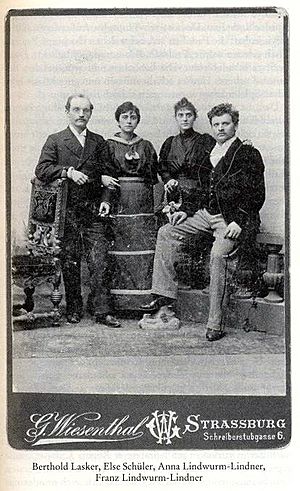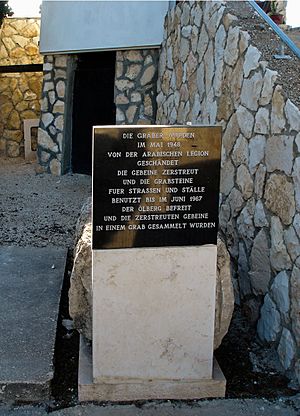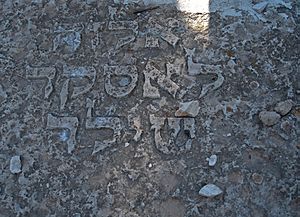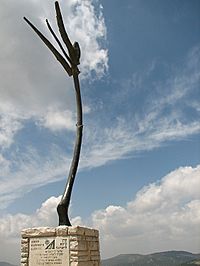Else Lasker-Schüler facts for kids
Quick facts for kids
Else Lasker-Schüler
|
|
|---|---|
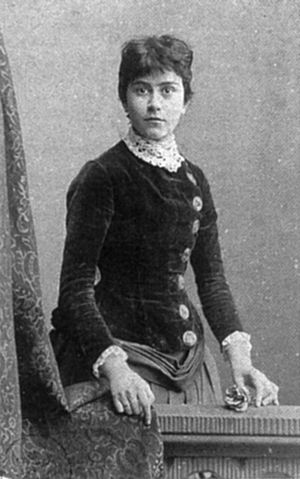
Else Lasker-Schüler shortly after her first marriage
|
|
| Born | Elisabeth Schüler 11 February 1869 Elberfeld, North German Confederation (today: Wuppertal, Germany) |
| Died | 22 January 1945 (aged 75) Jerusalem, Mandatory Palestine |
| Occupation | Poet |
Else Lasker-Schüler (born Elisabeth Schüler) (February 11, 1869 – January 22, 1945) was a German-Jewish poet and writer. She was known for her unique poetry and her free-spirited, artistic lifestyle in Berlin. She was one of the few women involved in the Expressionist art movement. Lasker-Schüler had to leave Nazi Germany and spent the rest of her life in Jerusalem.
Contents
About Else Lasker-Schüler
Else Lasker-Schüler was born in Elberfeld, which is now part of Wuppertal, Germany. Her mother, Jeannette Schüler, was a very important person in her poems. Her father, Aaron Schüler, was a Jewish banker, and he inspired a main character in her play Die Wupper. Else's brother Paul died when she was 13 years old.
Else was considered a very smart child because she could read and write when she was only four. She went to school from 1880, but later left and was taught at home.
In 1894, Else married Berthold Lasker, a doctor and chess player. They moved to Berlin, where she studied art. Her mother died in 1890, and her father died seven years later. In 1899, her son Paul was born, and her first poems were published. Her first book of poetry, called Styx, came out in 1902.
In 1903, she divorced Berthold Lasker. Later that year, she married Georg Lewin, an artist who started the Expressionist magazine Der Sturm. Else even gave him his famous pen name, Herwarth Walden.
Her Early Writings
Else Lasker-Schüler's first prose (story) book, Das Peter-Hille-Buch, was published in 1906. This was after her close friend Peter Hille passed away. In 1907, she published another collection of stories called Die Nächte der Tino von Bagdad. Her play Die Wupper came out in 1909, but it wasn't performed on stage until much later.
In 1911, her poetry book Meine Wunder was published. This book helped her become known as a leading female writer in German expressionism.
Life Challenges and Exile
After separating from Herwarth Walden in 1910 and divorcing him in 1912, Else had no money. She had to rely on her friends for help, especially a writer named Karl Kraus. In 1912, she met Gottfried Benn, another poet. They became very close friends, and she wrote many love poems for him.
In 1927, her son Paul died, which made her very sad.
In 1932, she won the Kleist Prize, a very important award for writers. However, because she was Jewish, she was attacked and threatened by the Nazis. She had to leave Germany and moved to Zürich, Switzerland. But she couldn't work there either. So, in 1934, she went to the Holy Land (now Israel), and finally settled in Jerusalem in 1937. In 1938, Germany took away her citizenship. When World War II started, she couldn't go back to Europe.
According to Yehuda Amihai, who translated her work into Hebrew, she lived a poor life in Jerusalem. Children in the neighborhood sometimes made fun of her because of her unusual clothes and behavior.
She started a literary group called “Kraal” at the French Cultural Center in 1942. Important Jewish writers and young poets attended her events. However, Lasker-Schüler was eventually stopped from giving readings because she spoke in German. She even asked a rabbi in Jerusalem if she could use his synagogue one last time to read her poems.
In her last years, Lasker-Schüler worked on a play called IchundIch (I and I), but she didn't finish it. She did finish her poetry book, Mein Blaues Klavier (My Blue Piano), which was printed in a small number of copies in 1943.
She dedicated this book to her friends in Germany and to those who, like her, were forced to leave their homes. In one of her last wishes, she asked that her hometown of Wuppertal be saved from Allied bombing during the war.
Else often spent all her money at once, which meant she sometimes went days without food or a place to stay. Her friends Heinz Gerling and Manfred Schturmann helped her. Gerling set up a bank account for her so she would get regular payments. Schturmann helped her with her writings and publishers. After she died, Schturmann managed her literary works.
Else Lasker-Schüler's health got worse in 1944. She had a heart attack on January 16, 1945, and died in Jerusalem on January 22, 1945. She was buried on the Mount of Olives.
Else Lasker-Schüler's Literary Works
Else Lasker-Schüler wrote many poems, three plays, and many short stories, essays, and letters. During her lifetime, her poems appeared in different magazines. These included Der Sturm, edited by her second husband, and Die Fackel, a literary magazine by Karl Kraus. She also published many collections of her poems, and she even drew the pictures for some of them herself.
Here are some of her poetry collections:
- Styx (her first poetry book, 1902)
- Der siebente Tag (her second poetry book, 1905)
- Meine Wunder (first edition, 1911)
- Gesammelte Gedichte (complete poetry) (1917)
- Mein blaues Klavier (1943)
She wrote her first and most important play, Die Wupper, in 1908. It was published in 1909 and first performed on April 27, 1919, at the Deutsches Theater in Berlin.
Much of her work is about love. But she also wrote deeply religious poems and prayers. Her later works often used ideas from the Bible and the Middle East. Else Lasker-Schüler was very creative with how she wrote her poems, often breaking traditional rules. This made her works feel very focused and powerful. She also liked to invent new words.
A great example of her poetic style is her 1910 poem "Ein alter Tibetteppich" (meaning "An old Tibetan rug"). This poem was printed many times after it first appeared in Der Sturm.
|
"Ein alter Tibetteppich" |
"An old Tibetan rug" |
Remembering Else Lasker-Schüler
There is a special plaque for Else Lasker-Schüler at Motzstraße 7 in Berlin-Schöneberg, where she lived. Part of this street was renamed Else-Lasker-Schüler-Straße in 1996. In Elberfeld, Wuppertal, there is a school named after her, and a memorial stone was put up on Herzogstraße.
The Else-Lasker-Schüler-Society was started in 1990 in Wuppertal. This group holds many international meetings to discuss her works and how they are still important today.
In Jerusalem, there is a small street named for Else Lasker-Schüler in the Nayot neighborhood. There was also a sculpture in her honor in the Jerusalem Forest, shaped like a tree trunk with wings. It was placed there in 1997 but was sadly stolen in 2007.
In 2007, a BBC radio play called My Blue Piano told the story of her last days in Jerusalem. On February 7, 2020, Google honored her with a special Google Doodle.
Films About Else Lasker-Schüler
- Ich räume auf ("Putting Things Straight") (Germany 1979): This film shows German actress Gisela Stein playing Else Lasker-Schüler as she deals with her editors.
- Mein Herz – niemandem! (1997): This film by Helma Sanders-Brahms features Lena Stolze as the poet. It explores her strong connection with Gottfried Benn, a poet who supported the Nazi government, even as Lasker-Schüler was forced to leave Germany.
English Translations of Her Work
Poetry
- Translated poems from nine poets including Lasker-Schüler.
- Bilingual edition.
Prose
- Translation of the novel Mein Herz.
- Translation of Konzert.
Plays
- Translations of Die Wupper, Arthur Aronymus : die Geschichte meines Vaters, and Ich und ich: Ein nachgelassenes Schaauspiel.
See also
 In Spanish: Else Lasker-Schüler para niños
In Spanish: Else Lasker-Schüler para niños


